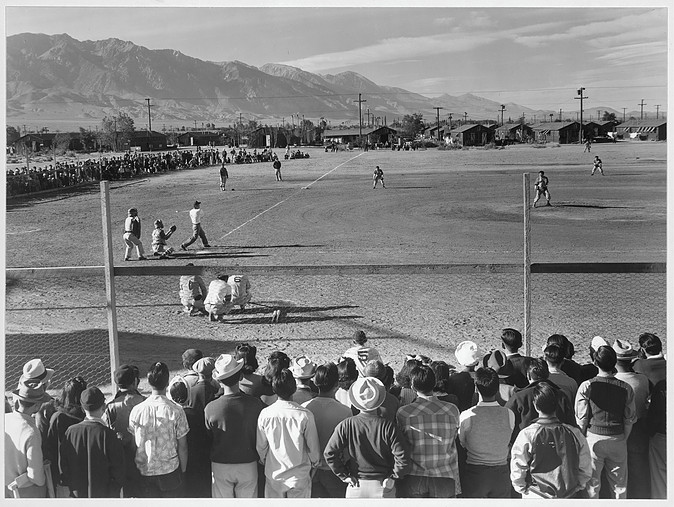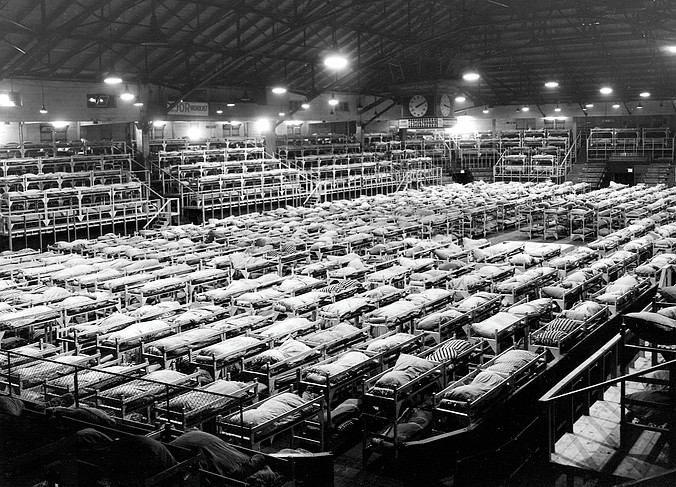Two Views-Photographs by Ansel Adams and Leonard Frank
By Emma Hamilton-Hobbs, MA Candidate Art History
Two Views – Photographs by Ansel Adams and Leonard Frank,
North Corridor, Canadian War Museum, Ottawa
20 September 2013 – 23 March 2014
The travelling exhibition, Two Views – Photographs by Ansel Adams and Leonard Frank, currently on display at the Canadian War Museum, brings together thirty-five black and white photographs that document the various experiences of Japanese Canadians and Japanese Americans imprisoned within internment and work camps during the Second World War.
After Japan’s attack on Pearl Harbor on December 7th, 1941, nearly 22,000 Japanese Canadians and 120,000 Japanese Americans were forcibly relocated from coastal regions of western North America to these camps. The opening of Two Views coincides with the 25th anniversary of the official apologies in 1988 by former Canadian Prime Minister Brian Mulroney and the United States Congress to citizens of Japanese ancestry for their treatment during and after the war. This exhibition is meant to build upon the museum’s other Second World War displays and underlines how these events continue to shape our present.
Organized by the Nikkei National Museum in Burnaby, British Columbia, the photographs that are displayed in this exhibition were taken by renowned American photographer Ansel Adams (1902-1984), best known for his landscapes of the American West, and Canadian photographer, Leonard Frank (1870-1944). Working in separate geographic locations but with similar subject matter, Adams and Frank captured rare views of everyday life inside these camps, including photographs of men’s sleeping quarters, a woodworker in his shop, and even a baseball game. While the images these two photographers produced are similar in some ways, their respective photographic approaches present us with different narratives.

Ansel Adams, Baseball Game, Manzanar Relocation Center, 1943.
Courtesy of the Library of Congress, Prints and Photographs Division, LOC-DIG-ppprs-00369.
From 1943 to 1944, Adams made several trips at his own expense to the Manzanar War Relocation Center in California, where 10,000 Japanese Americans were incarcerated. The extreme weather throughout the summer and winter months, combined with harsh living conditions, undoubtedly made life difficult for those imprisoned inside this camp. Nevertheless, Adams’ photographs illustrate the continued perseverance and solidarity within this community as they struggled to carry on with their lives. He explained: “The purpose of my work was to show how these people, suffering under a great injustice, and loss of property, businesses and professions, had overcome the sense of defeat and despair by building for themselves a vital community in an arid (but magnificent) environment…” (1)
Adams’ sense of compassion for his subjects is reflected in four individual portraits of young Japanese American men and women. This series both highlights and celebrates the individuality of his subjects, which is emphasized by the fact that each person is identified by their full name (Frank’s subjects are never identified). One of his portraits, titled Tom Kobayashi (head against the sky), is particularly striking. A close-up profile view of a young man gazing heroically into the distance presents the viewer with an image of determination, resistance and hope.
Leonard Frank, on the other hand, has been criticized for his ‘clinical view’ of the Canadian internment camps. In 1942, Frank accepted a contract from the British Columbia Security Commission to record the removal of Canadians of Japanese descent from the British Columbia coast. He was given access to the buildings at Hastings Park, in Vancouver, all the interment camp sites in British Columbia, and other resettlement sites in Alberta, Manitoba and Ontario.
Largely devoid of people, Frank’s images have been said to reflect ‘a more dispassionate documentation’ of the government process in Canada and its impact on the people interned. However, Canadian War Museum’s Dr. Amber Lloydlangston, Acting Historian of Art and War, has noted that his message is perhaps a little more subtle. She names two photographs in particular, Building K, men’s dormitory (formerly the Forum), with its rows of harsh straw mattresses, and Building B, baggage room (formerly the Horse Show building), with its glaring lights and abandoned luggage, as two examples of images that speak to the personal experiences of Japanese Canadians interned within these camps.(2)

Building K, men’s dormitory (formerly the Forum)
Leonard Frank. Hastings Park, Vancouver, British Columbia, 1942.
JCNM 1994.69.3.18, Eastwood Collection.
Regardless of these two photographers’ different approaches, it is important to consider the collective value of their work currently on display in Two Views. As visual remnants of a regrettable past, they help paint a broader picture of American and Canadian wartime experiences within the museum, and contribute to the ongoing healing and reconciliation dialogues within our communities today.
Notes
(1) Ansel Adams, quote from a letter to the Library of Congress on the occasion of the donation of his internment camp photographs.
(2) Robyn Jeffry, “Two Views – Photographs by Ansel Adams and Leonard Frank at the Canadian War Museum,” National Gallery of Canada Magazine, December 17 2013. http://www.ngcmagazine.ca/correspondents/two-views-photographs-by-ansel-adams-and-leonard-frank-at-the-canadian-war-museum
